The Women of Maine’s Whitewater

The Women of Maine’s Whitewater
These paddlers are making the state’s waterways a place for everyone.
By Jenny O’Connell
Photography by Andy Gagne
Issue: May 2021
If we forgot the name of a rapid, we had to swim it. We carried 200-pound rafts over our heads. Propelled by the shouts of our trainers we moved with a frantic urgency, running everywhere in wetsuits and wolfing down peanut butter sandwiches on the bus between runs so we could pack in the most laps daily down the swift, dark Kennebec. In 2018 I became a Maine river guide. And, while I treasured every second I was on the water, something nagged at me: I was one of five women in a class of 20. All of our trainers were men.
Where were the women? As raft guide Nancy Soule puts it: “We’re here, we’ve been here since the beginning, and we aren’t going anywhere.” The fierce females who have built their lives around Maine rivers shoot rapids in kayaks, rafts, canoes, SUPs, or flippers and a river-board. They drop waterfalls; they’ve paddled the Grand Canyon. They’ve met, married, and, in a few cases, lost loved ones on the river. Their children surf in its waves. Whether they grew up on whitewater or are just starting out, they all feel its pull.
Last summer, I set out to meet them.
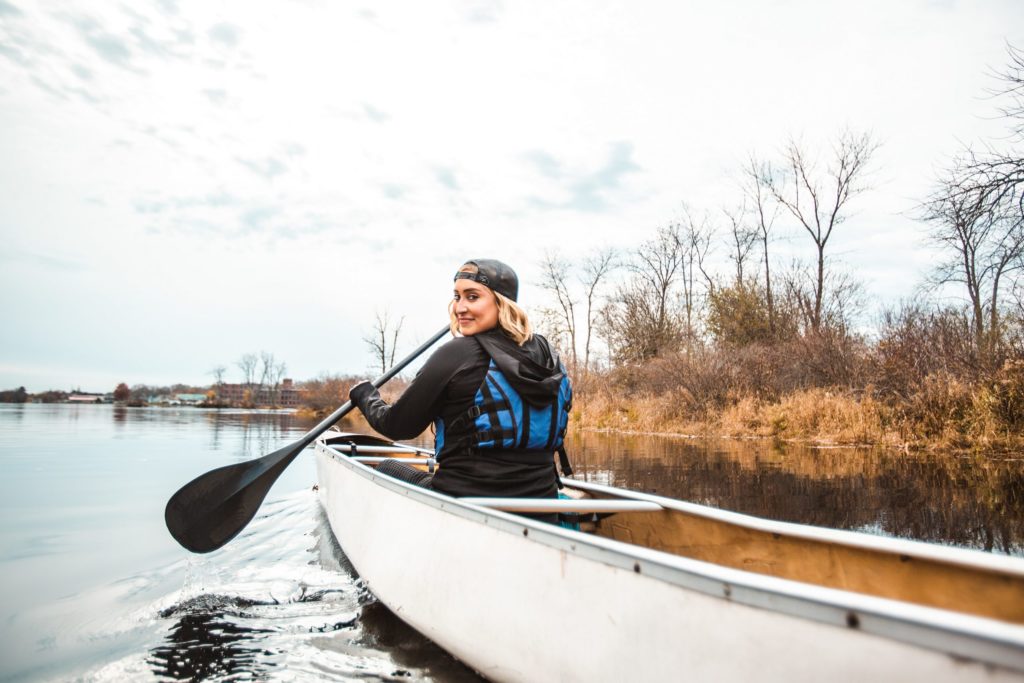
“Anywhere you go—north, south, east, or west—the river’s there,” says canoeist Eve Dana, 32. Dana, who grew up on Indian Island, learned how to canoe from her father, former Penobscot Nation chief Barry Dana. Passionate about preserving Wabanaki traditions, he passed on his respect for the river and love for paddling to his daughter. “It’s part of our culture—being on the water, being outdoors and enjoying nature,” she says. The Penobscot people, who have been paddling Maine’s rivers since before recorded history, have been frontline water protectors for years, fighting to restore Atlantic salmon and defending the river’s fragile ecosystem from the effects of colonization, damming, and industry. “When I’m on the river I say I’m going to church,” Dana says. “It’s my happy place.”
Dana, who rode in canoes before she could walk, began whitewater racing in high school—a passion that intensified years later when she started a job with Dr. Bill Deighan, an oral surgeon and avid boater. With the encouragement and companionship of Deighan and her father, Dana competed on creeks, streams, and rivers all around Maine, paddled the 70-mile General Clinton canoe race in upstate New York, and even won the mixed division at the 2016 Penobscot River Whitewater Nationals. But for Dana it isn’t all about winning. “When I’m racing, something comes over me,” she says. “I love paddling. It’s who I am. I grew up on the river. It’s named after my tribe. It’s a huge part of the person I’ve come to be.”
Farther upstream, where the Penobscot begins its 240-mile journey from the pine forests of Baxter State Park to the Atlantic, Jacquie Martin, 35, fell in love with the river as a girl. “My connection to whitewater started before I even realized it,” Martin says. She recalls driving past the river on hunting trips with her dad, her face plastered against the truck window, watching the whitewater. As soon as she was old enough, Martin began working for local outfitters, where she seized every opportunity to jump into a raft. At 16, she was launched from a boat and had to swim Cribworks, a Class V rapid on the Penobscot—with its major waves, recirculating holes, and little margin for error, it is considered the fourth-most technical rapid in the United States. “I think you can come out of that experience in one of two ways,” Martin says. “Either I’m never doing that again, or I’m going to be a raft guide.”
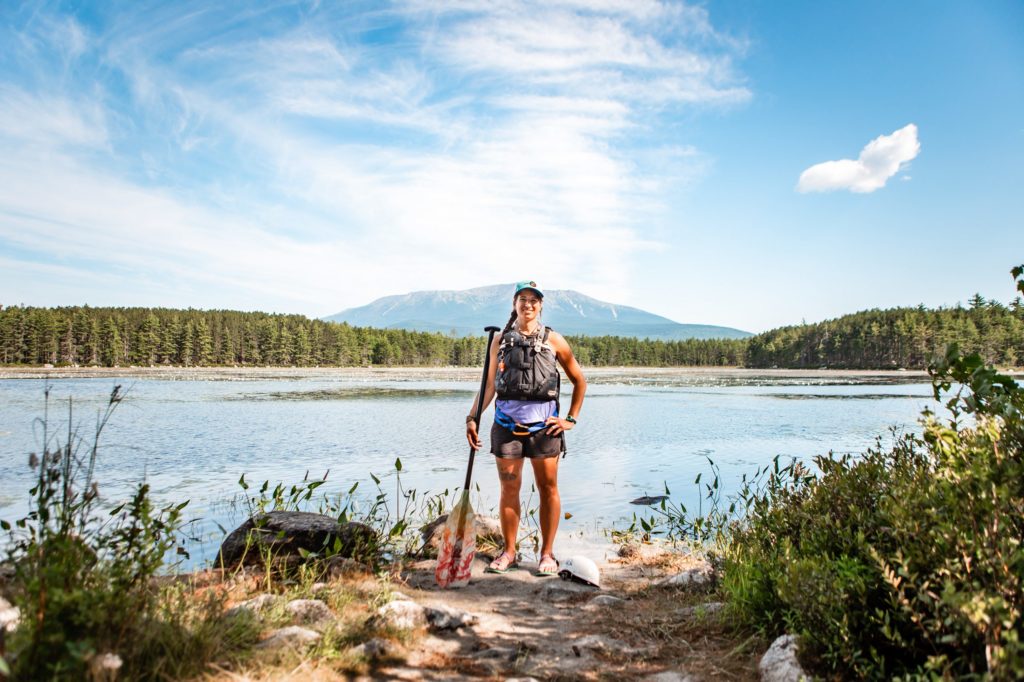
Once she graduated from high school, Martin earned her license and began guiding for New England Outdoor Center (NEOC), where she met her husband, Garrett, another raft guide. They were married above Cribworks. Their wedding gift was a raft.
After the birth of her two children, Martin struggled with her identity. “It’s hard to figure out where you fit into life after you have kids,” she says. “Part of me always thought: Is this the right thing to do? There’s danger. Is it selfish? But on the other hand, someone’s gotta be there to show people that, just because you’re a mom, it doesn’t mean you give up the things you love.” This year will be her eighteenth season as a raft guide, and Martin feels passionately about connecting youth to the river. “I’m so looking forward to the day when I can arc through Cribworks with my daughter,” she says. “I want to raise a new generation that loves the water, and nature in general.”
From the previous generation of paddlers, Suzie Hockmeyer, 69, is a pioneer of commercial rafting in Maine, and the first woman to become a licensed Maine whitewater guide. In 1976, shortly after log driving ended on the Kennebec River, Hockmeyer and her former husband, Wayne, sent the first commercial raft down the gorge. The section of river below Harris Station Dam is narrow and fast, with sheer cliffs and big waves, so the Hockmeyers—who at the time knew very little about rafting—hired a scouting team of professional guides from West Virginia. Plans fell through at the last minute. “We had put every cent we had into this project,” Hockmeyer says. “We had to do it.” They ran it themselves, with a boatful of bear hunters.

This was before helmets, modern life jackets, and self-bailing rafts. The whole turbulent 12 miles down, the crew bailed water out of the boat with hats and boots. “One man kissed the ground when he got out,” Hockmeyer remembers. “But everyone emerged thrilled and having fun.” That summer, they ran 600 people down the river. Today, Northern Outdoors, the rafting company Hockmeyer now co-owns, guides approximately 9,000 people down the Kennebec, Dead, and Penobscot Rivers each season.
Over the years, Hockmeyer has played a key role in the Kennebec Valley rafting community, brokering cooperation between competing companies, training guides, and making the river a place for families as well as thrill seekers. And while whitewater women across the board say they feel supported and encouraged by the men in the sport, Hockmeyer—nicknamed “Queen of the Kennebec”—offers something else: female representation in leadership. “[Boaters] come in all shapes and sizes,” says Hockmeyer, who was 5’3” and 115 pounds when she started guiding. “As long as you’ve got an adventurous spirit and are comfortable in water, you’ll catch on.”
One of those adventurous spirits is Cynthia Hanlon-Salinas, 30, of Manchester, Connecticut, whose first time in a raft was down the Class V Penobscot. “I remember pulling the boat out into the water, and just thinking to myself, What the hell am I doing?” Hanlon-Salinas says. But when she hit the first rapid, she only felt elation. “I was in my element.”
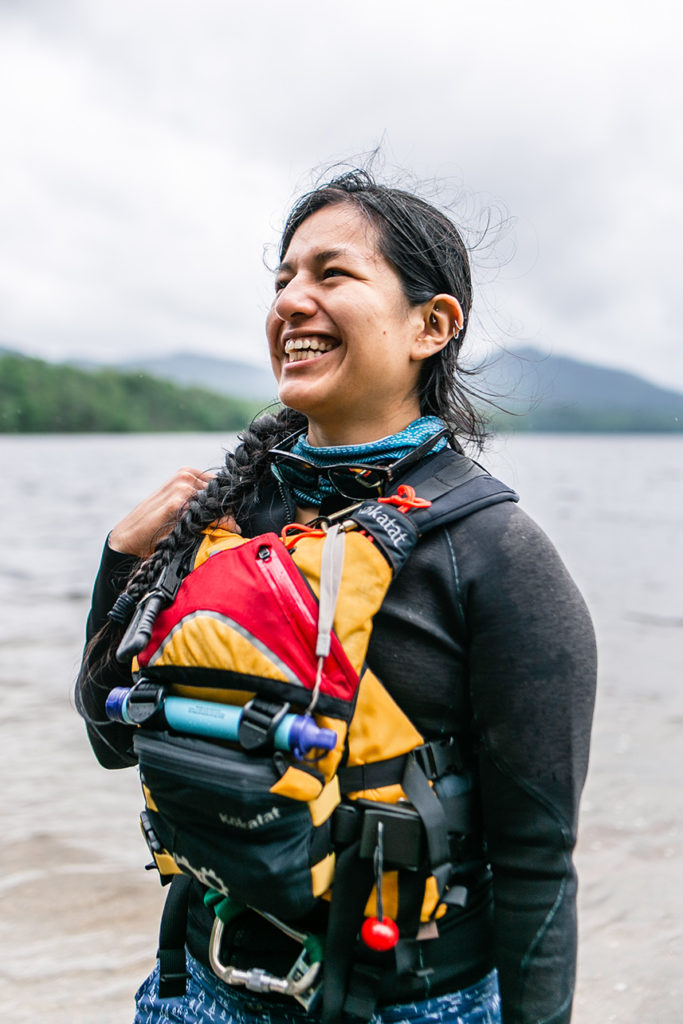
Cynthia Hanlon-Salinas, who drives five-and-a-half hours from Connecticut on free weekends to guide the Kennebec, credits the river for teaching her teamwork and patience, and empowering her to overcome her fears. 
Hanlon-Salinas and her husband, Michael.
Every year, Hanlon-Salinas and her husband, Michael, make a seven-hour pilgrimage to Baxter State Park to hike and raft. When a guide from Three Rivers Whitewater noticed their return trips and suggested they sign up for guide training, they jumped at the chance. The grueling weeklong training served as a milestone in their relationship: when the boat hit shore on the Dead River that last day, Michael pulled out the ring he had been carrying in his life jacket pocket, wrapped in a bandage. “That entire week was so rough,” Hanlon-Salinas says. “Michael had open wounds and blisters. I’m seeing this bandage in his hand, and he’s starting to unravel it, and I’m like, Why does he want me to do his wound care now?” To her surprise, Michael got down on one knee. “After this week, I know that we can make it through anything,” he told her.
After training, the two became “weekend warriors”— people who work nine-to-five jobs but head to the river whenever possible. Although pandemic and life circumstances have since interfered with the frequency of their river trips, every other weekend that first season they’d drive the five and a half hours from Manchester, where Hanlon-Salinas works as a pediatric respiratory therapist, to the Forks to guide for Three Rivers. “I loved it,” she says. “I was the strongest I could be.” Hanlon-Salinas, who dreams of opening an outdoor company of her own someday, credits the river for teaching her teamwork and patience, and empowering her to overcome her fears. “Every time I go on the river, I take these big breaths,” she says. “I’m out in the open, just able to do my thing.”
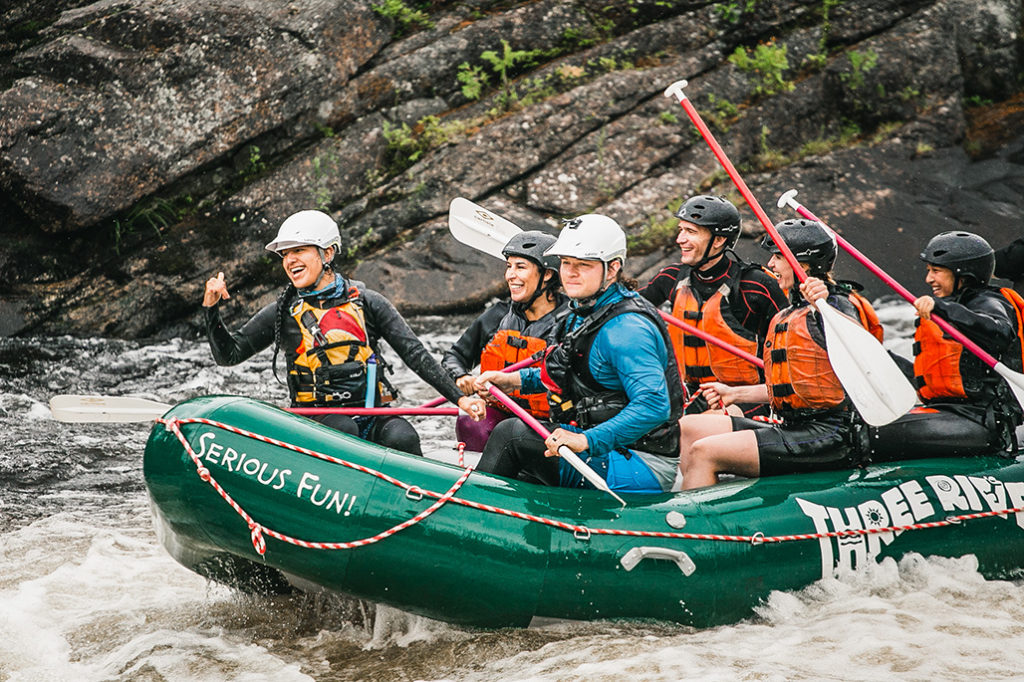
Jessie Sterling, 34, one of the best female kayak racers in New England, started paddling after a bad rock-climbing accident in 2015 landed her in a wheelchair. “Kayaking gave me something to push for,” she says. “I taught myself how to roll with two broken legs.” Initially from Boston, she found the Maine paddling community welcoming and willing to teach her. “That first run down the gorge, what they told me was, ‘If you’re nervous, paddle hard,’” she says. “I was so nervous, I took off like a shot.” Sterling’s fellow kayakers had to chase her down the river. “And that was it,” she says. “I raced after that.”
In the past four years, Sterling—a team paddler for Level Six, Pyranha Kayaks, and Outdoor New England—has risen to the top of New England’s racing circuit, winning numerous competitions, dropping 40-foot waterfalls, and muscling her way into higher stakes whitewater situations, where women are rarer. Accessing the next level of challenge wasn’t always easy. “The moment you start wanting to run [the big drops], they’re like, ‘Well, who brought the Barbie Doll?’” Sterling says. But she persisted. “I’m going to do this whether you help me or not,” she told her skeptics. “Probably better if you do, because I am very attached to living. But I’m doing this, with your help or otherwise.”
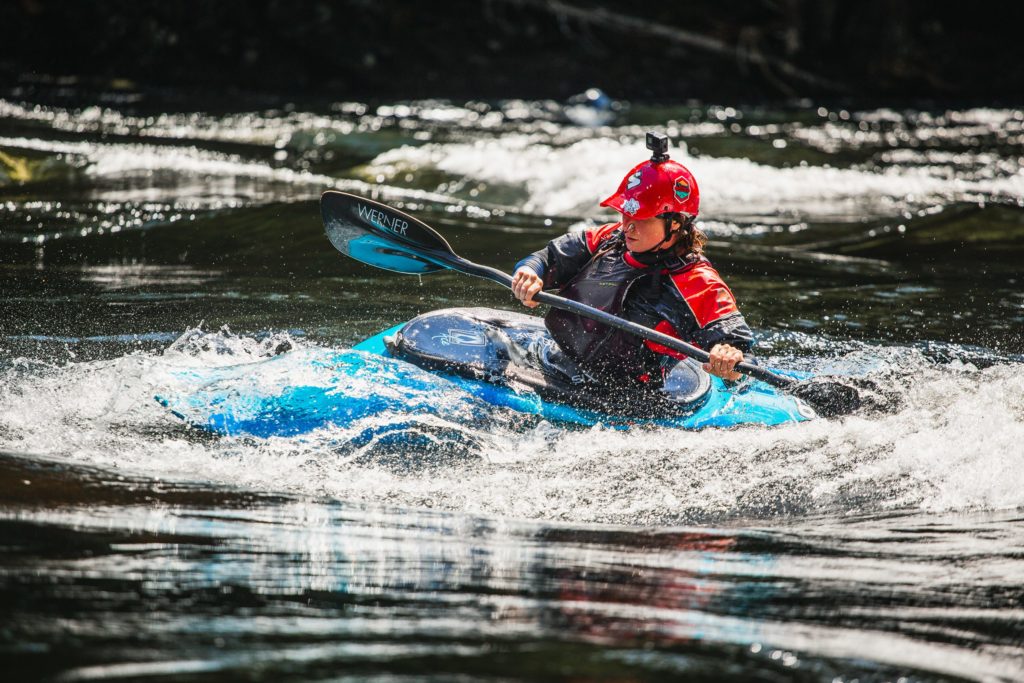
Sterling notes the lack of women in whitewater kayaking, and hopes her example will inspire more to join. “That’s part of the reason I keep racing,” she says. “If we stop, there’s nobody. You can definitely beat me if you want to. You just have to be there.”
In Sterling’s statement lies the crux of my search: what I was missing at that 2018 training was myself, reflected. I wanted to know there were women in leadership positions. I wanted to see people who looked like me shooting the harder rapids. I wanted this so I could find that same courage in myself. In the words of Caitlyn Tisdale, who’s been paddling the Kennebec for years: “The paddling community in Maine is extremely welcoming to all genders, and there’s a very diverse community of people from all walks of life, backgrounds, and experiences to support you in whatever goals and ambitions you have with whitewater.”
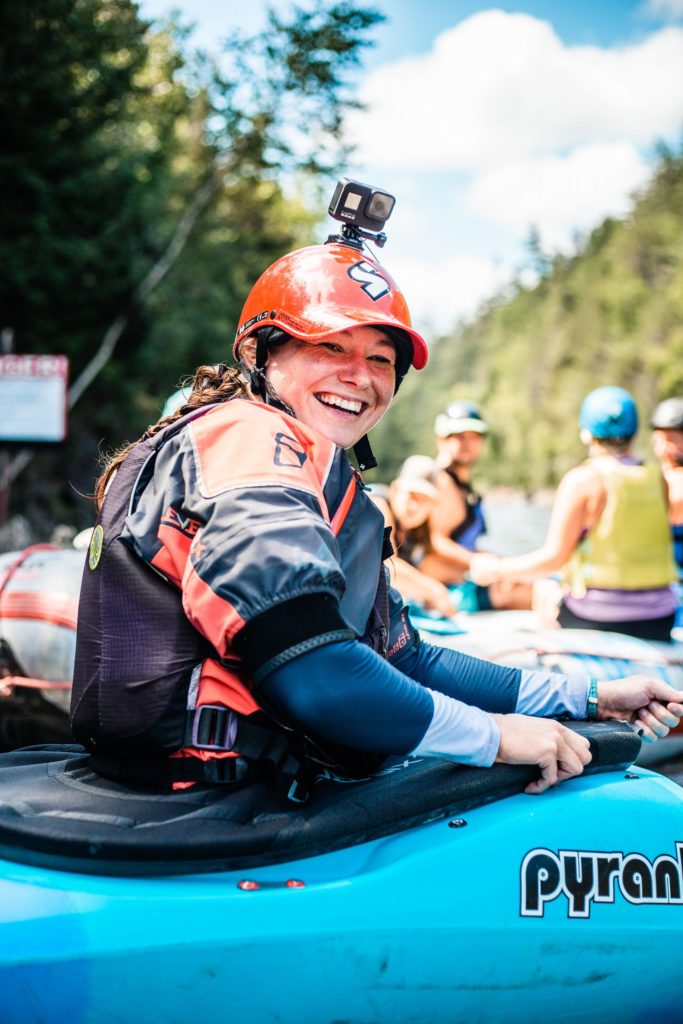
Jessie Sterling echoes the call for more women to join the Maine whitewater community: “You can definitely beat me if you want to. You just have to be there.” 
Rafters brace for impact as Jacquie Martin guides her boat through Cribworks, a Class V rapid on the Penobscot that is considered the fourth-most technical rapid in the United States.
Although diversity may not be the first thing you see on the river, it’s there. And the river will only truly become a place for everyone if inclusive spaces are intentionally created; if paddlers of all identities can see themselves guiding, leading, and pushing their limits on the river.
The river woman is a bartender, shuttle driver, weekend warrior, company owner, water protector, mother, guide. She wakes when it’s raining and wonders what streams are running; packs her car at first light; leaves work early to catch the dam release. She speaks the river’s name with an almost religious reverence: a place of peace, of power and energy, of healing, of truest self, of home. On these waters she’s learned problem solving and quick decision-making skills, found confidence and voice, taken risks and faced fears. She lives for that trembling line between elation and destruction, the feeling of riding a white blade of water around boulders, eddies, and holes, over waves and waterfalls. She paddles it as hard as anyone.
She’s here, she’s been here since the beginning, and she isn’t going anywhere.


